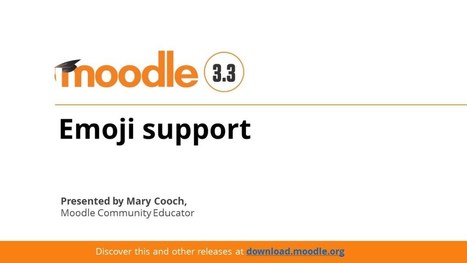Some decry emojis as evidence that new generations are regressing back to the times of hieroglyphs. For others, they are an exciting area of study in the realm of communication in the digital age. But either way, for better or worse, emojis are here to stay. And now, with the latest upgrade to the most widespread LMS in the world, emojis are now part of classrooms everywhere Moodle 3.3 is running.
Interestingly enough, making sure Moodle could accurately send, receive, store, and render emojis across pages and activities made it necessary to modify the very encoding of Moodle data. The default technology that powers Moodle’s database is MySQL, an open source relational language to store and query data. Before Moodle 3.3, characters on the MySQL were only “three-byte UTF-8 encoding,” allowing for a smaller set of characters. To make emojis possible, the MySQL database coming with Moodle 3.3 boasts four-byte encoding, exponentially increasing the number of characters MySQL can accurately process. Four-byte UTF-8 encoding, the default specification for modern websites, not only makes emojis possible, but it also improves Moodle compatibility with richer character sets, such as Japanese, Chinese, and Korean.
This has an important implication for users upgrading an existing database to Moodle 3.4: a conversion to “full” (four-byte) UTF-8, also called ‘utf8mb4‘ may be necessary. Read more about how to perform the conversion here.
Interestingly enough, making sure Moodle could accurately send, receive, store, and render emojis across pages and activities made it necessary to modify the very encoding of Moodle data. The default technology that powers Moodle’s database is MySQL, an open source relational language to store and query data. Before Moodle 3.3, characters on the MySQL were only “three-byte UTF-8 encoding,” allowing for a smaller set of characters. To make emojis possible, the MySQL database coming with Moodle 3.3 boasts four-byte encoding, exponentially increasing the number of characters MySQL can accurately process. Four-byte UTF-8 encoding, the default specification for modern websites, not only makes emojis possible, but it also improves Moodle compatibility with richer character sets, such as Japanese, Chinese, and Korean.
This has an important implication for users upgrading an existing database to Moodle 3.4: a conversion to “full” (four-byte) UTF-8, also called ‘utf8mb4‘ may be necessary. Read more about how to perform the conversion here.
Via Miloš Bajčetić



 Your new post is loading...
Your new post is loading...







